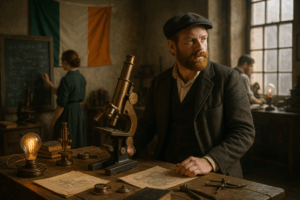10 Groundbreaking Irish Inventions That Shaped the Modern World

A representation of Irish innovation: an inventor in a traditional workshop surrounded by tools, blueprints, and the Irish flag
Ireland’s contributions to global innovation span centuries, with Irish inventors leaving an indelible mark across various fields. From pioneering medical devices to revolutionizing photography, here are ten remarkable Irish inventions that have significantly influenced our world.
1. Modern Chemistry – Robert Boyle (1661)
Often hailed as the “Father of Modern Chemistry,” Robert Boyle’s 1661 publication, The Sceptical Chymist, laid the foundation for modern chemical analysis. His formulation of Boyle’s Law, describing the inverse relationship between gas pressure and volume, remains fundamental in physics and chemistry today.(Wikipedia)
2. Hypodermic Syringe – Francis Rynd (1844)
In 1844, Dublin physician Francis Rynd performed the first recorded subcutaneous injection using a hollow needle of his own design. This groundbreaking procedure paved the way for the development of the modern hypodermic syringe, revolutionizing medical treatments worldwide. (Think Business, Wikipedia)
3. Color Photography – John Joly (1894)
John Joly, a physicist from County Offaly, introduced a practical method for producing color photographs in 1894. His innovation allowed for the capture of images in natural color using a single photographic plate, significantly advancing the field of photography. (Think Business, Kian Jackson)
4. Induction Coil – Nicholas Callan (1836)
Reverend Nicholas Callan, a professor at Maynooth College, invented the induction coil in 1836. This device could generate high-voltage electricity from a low-voltage source, playing a crucial role in the development of early electrical technologies and telecommunication systems.(Think Business)
5. Three-Point Linkage System – Harry Ferguson (1926)
Harry Ferguson, an engineer from County Down, revolutionized agriculture with his invention of the three-point linkage system for tractors in 1926. This mechanism allowed for safer and more efficient attachment of implements to tractors, transforming modern farming practices. (Wikipedia)
6. Guided Torpedo – Louis Brennan (1877)
Louis Brennan, born in Castlebar, County Mayo, developed the world’s first practical guided torpedo in 1877. Controlled via wires from the shore, Brennan’s invention was a significant advancement in naval weaponry and defense systems. (Think Business)
7. Portable Defibrillator – Frank Pantridge (1965)
Dr. Frank Pantridge from County Down introduced the portable defibrillator in 1965, a life-saving device that could be used outside of hospitals to treat cardiac arrest. His innovation has become a standard emergency medical tool, saving countless lives globally.(Wikipedia)
8. Radiotherapy for Cancer Treatment – John Joly (1901)
Beyond his work in photography, John Joly also pioneered the use of radiotherapy for cancer treatment in 1901. His method involved using radium to target and destroy cancerous cells, laying the groundwork for modern radiation oncology. (Kian Jackson)
9. Sugru – Jane Ní Dhulchaointigh (2003)
In 2003, Jane Ní Dhulchaointigh from Kilkenny invented Sugru, a moldable silicone-based material that can be shaped by hand and cures at room temperature. This versatile adhesive has been widely adopted for DIY repairs and creative projects. (Wikipedia)
10. Transatlantic Telegraph Cable – Lord Kelvin (William Thomson) (1865)
Irish-born physicist William Thomson, later known as Lord Kelvin, played a pivotal role in the successful laying of the first transatlantic telegraph cable in 1865. This monumental achievement revolutionized global communication, shrinking the world in unprecedented ways. (Braden Kelley)
Honorable Mentions
- Binaural Stethoscope – Arthur Leared (1851): Improved upon the monaural stethoscope by introducing a design that allowed for listening with both ears, enhancing diagnostic capabilities. (Arthur Leared)
- Ejection Seat – James Martin (1945): Invented a reliable ejection seat for aircraft, significantly improving pilot safety during emergencies.(Kian Jackson)
- Cure for Leprosy – Vincent Barry (1950s): Led a team that developed a treatment for leprosy, which has cured millions worldwide. (IrishCentral.com)
Conclusion
Ireland’s rich history of innovation has profoundly impacted various aspects of modern life. These inventors and their groundbreaking work continue to influence contemporary technology and medicine, underscoring Ireland’s enduring legacy in global advancement.

